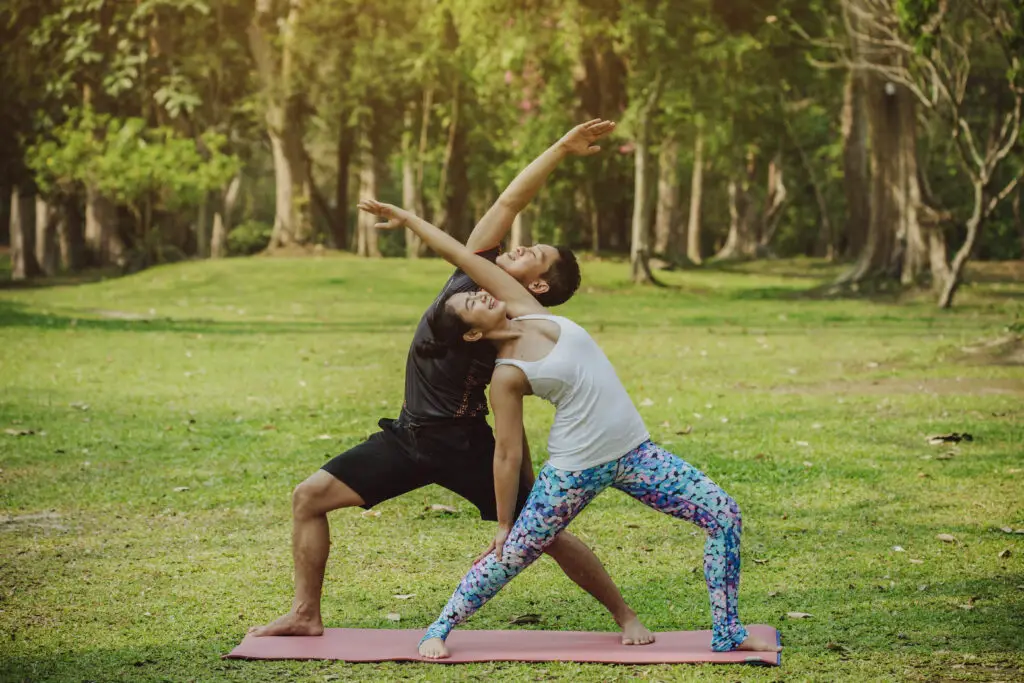
Introduction
In a fast-paced world filled with deadlines, responsibilities, and digital distractions, finding moments of genuine connection with our partners can be a challenge. The pursuit of balance in our lives often leads us to seek out activities that not only foster physical well-being but also strengthen the emotional bond with our significant other. This is where “Couple Yoga” comes into play, offering a unique blend of physical and emotional intimacy. In this comprehensive guide, we will delve deep into the world of Couple Yoga, exploring its origins, benefits, and practical tips for beginners and experienced practitioners alike.
Table of Contents
1: The Origins and Evolution of Couple Yoga
To truly understand the essence of Couple Yoga, it’s essential to delve into its roots and how it has evolved over time.
1.1 The Ancient Origins
Couple Yoga, also known as Partner Yoga, draws its inspiration from the ancient practices of yoga and tantra. The idea of uniting two souls through physical postures and breathing techniques has its roots in these centuries-old traditions. Ancient texts like the Kamasutra have references to intimate yoga practices, emphasizing the connection between physical and spiritual intimacy.
1.2 The Modern Resurgence
While the concept of Couple Yoga has ancient origins, it experienced a resurgence in the 20th century. Pioneers like B.K.S. Iyengar introduced partner yoga as a way to deepen the practice of yoga and create a stronger bond between couples. This modern interpretation combined the principles of traditional yoga with a focus on trust, communication, and unity.
2: The Benefits of Couple Yoga
Before diving into the practice itself, it’s crucial to understand the numerous physical, emotional, and relational benefits that come with Couple Yoga.
2.1 Physical Benefits
- Enhanced Flexibility: Couple Yoga postures often require partners to assist each other in stretching, leading to improved flexibility over time.
- Strength Building: Many partner poses involve supporting each other’s weight, which can help build muscle strength.
- Improved Balance: Partner Yoga challenges balance and stability, enhancing overall coordination.
2.2 Emotional Benefits
- Trust and Communication: Couple Yoga requires partners to communicate effectively and trust each other completely, fostering better emotional connection.
- Stress Reduction: Like traditional yoga, Couple Yoga promotes relaxation and reduces stress levels, leaving both partners feeling more at ease.
- Increased Intimacy: The physical closeness and shared experience of Couple Yoga can reignite the spark in a relationship, leading to a deeper emotional connection.
2.3 Relational Benefits
- Teamwork: Partner Yoga teaches couples to work together as a team, promoting a sense of unity and cooperation.
- Conflict Resolution: Learning to navigate challenges and balance in yoga poses can translate into better conflict resolution skills in the relationship.
- Quality Time: Couple Yoga provides an opportunity for couples to spend quality time together, away from screens and distractions.
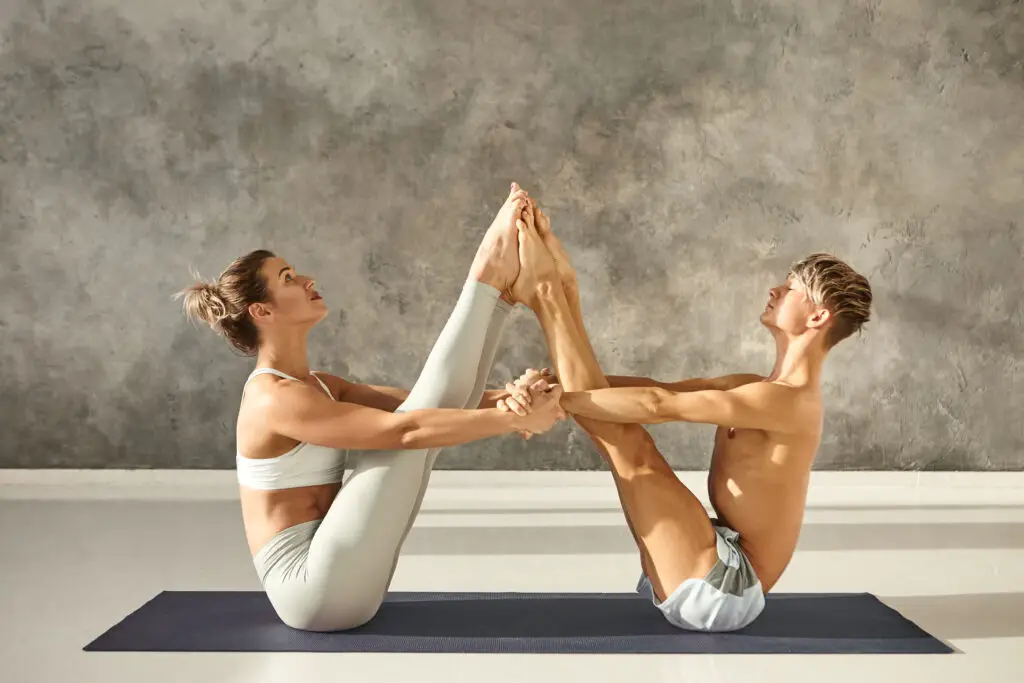
3: Getting Started with Couple Yoga
Now that we’ve explored the foundation and benefits of Couple Yoga, let’s take a closer look at how to get started with this transformative practice.
3.1 Finding the Right Partner
- Choosing Your Partner: While Couple Yoga is often associated with romantic couples, it can also be practiced with friends, family members, or anyone you trust and feel comfortable with.
- Communication: Effective and transparent communication with your partner is absolutely essential. Discuss your goals, expectations, and any physical limitations or concerns before starting.
3.2 Creating the Right Space
- Space and Props: Designate a spacious, comfortable area for your practice. You may need yoga mats, bolsters, and blankets for added comfort and support.
- Lighting and Ambiance: Set the mood with soft lighting and calming music to create a serene atmosphere conducive to relaxation.
3.3 Beginning with Basic Poses
- Breathing Exercises: Start with simple breathing exercises to sync your breath with your partner. This helps establish a deeper connection from the outset.
- Warm-Up Poses: Begin with easy partner poses like “Seated Back-to-Back” or “Double Child’s Pose” to gently warm up your bodies.
4: Exploring Intermediate and Advanced Partner Poses
As you become more comfortable with Couple Yoga, you can progress to more challenging partner poses. These poses not only enhance your physical abilities but also strengthen your emotional bond.
4.1 Tree Pose Variation
- How to: Stand side by side with your partner, interlocking the leg closest to each other. Extend your outside arms upward, finding balance together. This pose encourages trust and balance.
4.2 Double Boat Pose
- How to: Sit facing your partner with your knees bent and feet touching. Hold hands and lean back while lifting your legs, creating a “V” shape. This pose strengthens your core and requires synchronized movement.
4.3 Partner Forward Fold
- How to: Sit facing your partner, with your legs spread in a wide straddle. Hold hands and gently lean forward, guiding each other into a deep stretch. This pose promotes flexibility and trust.
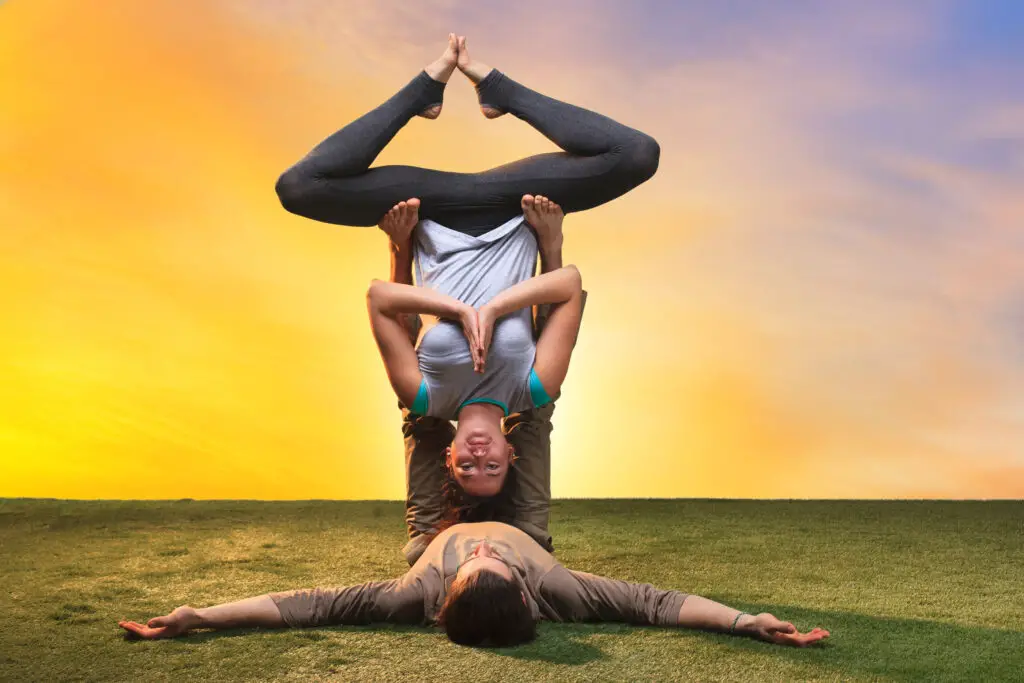
5: The Emotional Connection in Couple Yoga
Beyond the physical postures and exercises, Couple Yoga is a profound tool for strengthening the emotional connection between partners.
5.1 Mindful Presence
- Eye Contact: Maintaining eye contact during partner poses enhances the feeling of connection and presence.
- Intention Setting: Begin each practice with a shared intention or affirmation, reinforcing your commitment to each other.
5.2 Trust and Vulnerability
- Balancing Acts: Partner poses often require one partner to support the other, fostering trust and vulnerability in the relationship.
- Embracing Imperfection: Accept that not every pose will be perfect. The journey itself is an opportunity for growth and learning together.
5.3 Breath and Synchronization
- Breathing Together: Syncing your breath with your partner creates harmony and a sense of unity, both on and off the mat.
- Deepening Connection: As you breathe in unison, you can feel each other’s energy and emotions more deeply.
6: Overcoming Challenges in Couple Yoga
No practice is without its challenges, and Couple Yoga is no exception. However, these challenges can be opportunities for growth and deeper connection.
6.1 Patience and Understanding
- Frustration: It’s normal to feel frustrated when learning new poses. Practice patience and understanding toward yourself and your partner.
- Alignment Issues: Misalignments may occur, but they provide an opportunity to communicate and adjust together.
6.2 Physical Limitations
- Respecting Boundaries: It’s essential to respect each other’s physical limitations. Never push your partner into a pose that causes discomfort or pain.
- Adaptations: Modify poses to accommodate any physical restrictions or injuries.
6.3 Balancing Ego
- Ego Check: Remember that Couple Yoga is not a competition. Let go of any ego-driven expectations and focus on the journey together.
- Celebrating Progress: Celebrate your achievements, no matter how small, as a team.
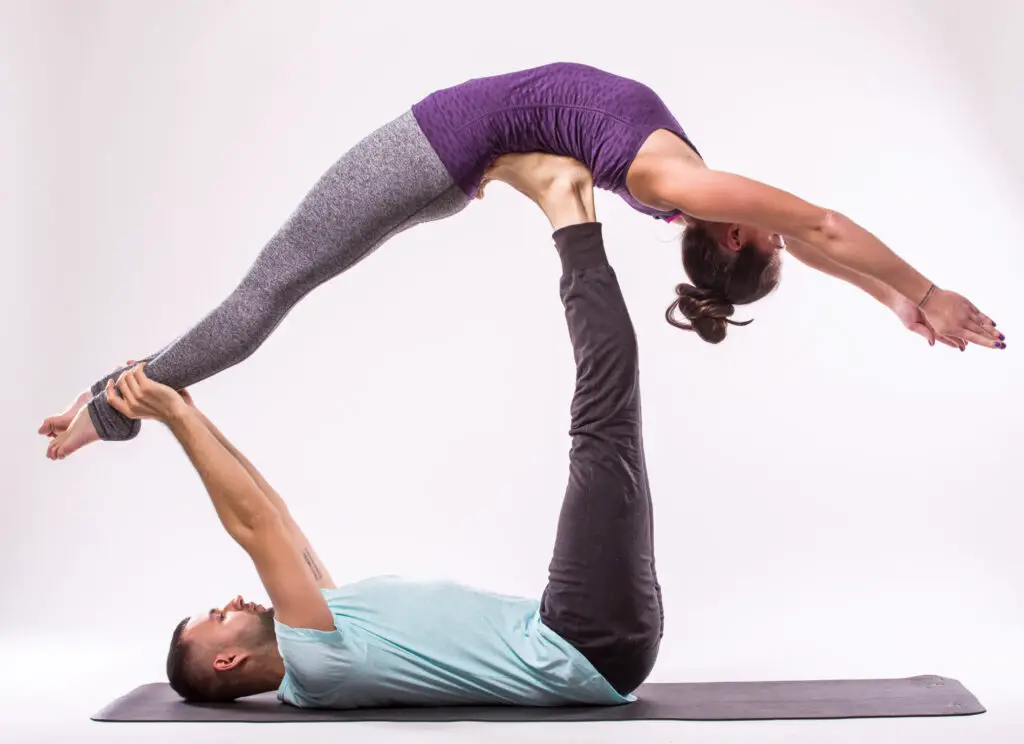
7: Taking Your Practice Beyond the Mat
While practicing Couple Yoga on the mat can greatly benefit your relationship, the lessons and connections you cultivate can extend into other aspects of your lives.
7.1 Communication
- Conflict Resolution: Apply the communication skills developed in Couple Yoga to resolve conflicts more effectively.
- Active Listening: Practice active listening to understand your partner’s needs and desires.
7.2 Quality Time
- Digital Detox: Make Couple Yoga a digital-free zone and extend this practice to other moments you share.
- Shared Hobbies: Explore other hobbies and activities you both enjoy.
7.3 Intimacy and Connection
- Date Nights: Schedule regular date nights to nurture your emotional and physical connection.
- Surprises and Affection: Surprise your partner with affectionate gestures to keep the spark alive.
8: Beyond Romantic Relationships
While Couple Yoga is often associated with romantic partnerships, its benefits can extend to other relationships as well.
8.1 Family Yoga
- Bonding with Children: Practicing Couple Yoga with your children can strengthen family bonds and create lasting memories.
- Siblings and Friends: Extend the practice to siblings, friends, or close relatives for a unique bonding experience.
8.2 Workplace Relationships
- Team Building: Incorporate partner yoga into team-building activities at work to foster trust and cooperation among colleagues.
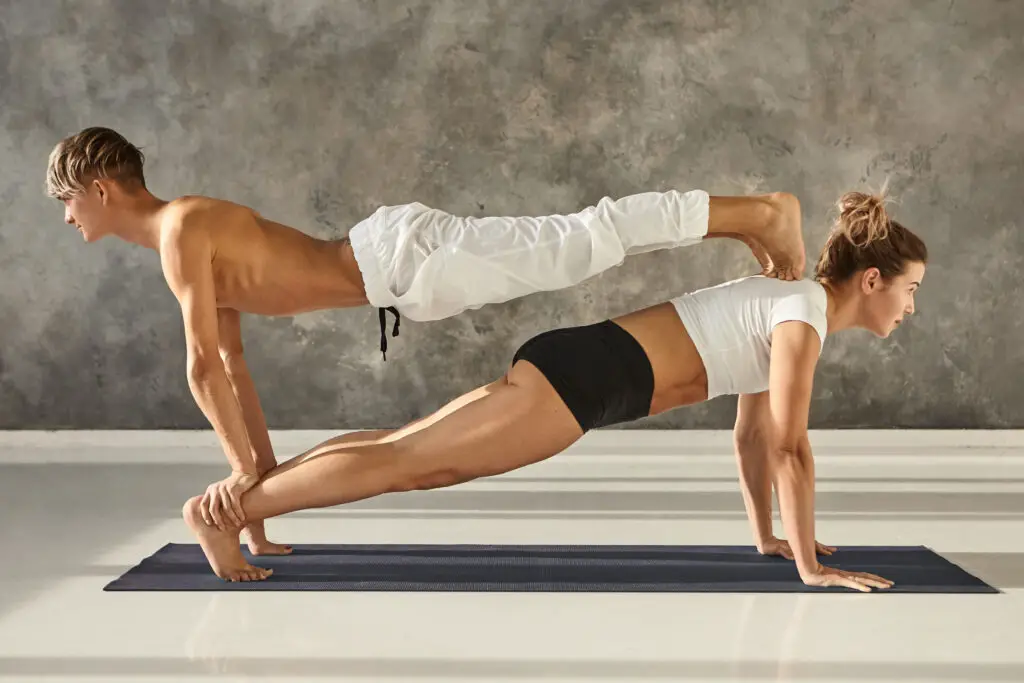
Conclusion: The Journey of Connection
Couple Yoga is a profound journey that transcends the physical realm, enriching the emotional and relational aspects of our lives. As we navigate the challenges and joys of practicing yoga with a partner, we discover the power of trust, communication, and unity. Through shared breaths, synchronized movements, and moments of vulnerability, we forge a deeper connection that can withstand the tests of time. Whether you embark on this journey with a romantic partner, a friend, or a family member, Couple Yoga offers a path to a more harmonious and connected life.
https://www.youtube.com/watch?v=tkUh9J6_AiE
So, why wait? Roll out your yoga mats, find a partner you trust, and embark on this transformative journey of togetherness through Couple Yoga.
Frequently Asked Questions (FAQs):
1. What is Couple Yoga, and how does it differ from regular yoga?
- Couple Yoga, also known as Partner Yoga, is a practice where two individuals come together to perform yoga postures, breathing exercises, and meditation. It differs from regular yoga as it emphasizes trust, communication, and physical connection between partners, creating a unique shared experience.
2. Do I need to have prior yoga experience to practice Couple Yoga?
- No, prior yoga experience is not necessary. Couple Yoga can be enjoyed by individuals of all fitness levels, including beginners. Start with basic poses and progress at your own pace.
3. Can I practice Couple Yoga with a friend or family member, or is it only for romantic couples?
- Couple Yoga is versatile and can be practiced with anyone you trust and feel comfortable with. It’s not limited to romantic couples and can be a bonding experience for friends, family members, or close relatives.
4. What are the benefits of practicing Couple Yoga for relationships?
- Couple Yoga offers several benefits, including enhanced trust, improved communication, stress reduction, increased intimacy, and quality time together. It can strengthen the emotional connection between partners, fostering a deeper relationship.
5. Are there specific poses suitable for beginners in Couple Yoga?
- Yes, there are beginner-friendly partner poses in Couple Yoga. These poses are designed to be accessible and help build trust and coordination between partners. Examples include seated back-to-back and double child’s pose.
6. How do I ensure safety while practicing Couple Yoga?
- Safety is paramount in Couple Yoga. Always communicate openly with your partner about your physical limitations and any discomfort you may experience. Start with simple poses, use props if needed, and prioritize your well-being throughout the practice.
7. Can Couple Yoga help with relationship issues or conflicts?
- While it may not directly resolve deep-seated conflicts, Couple Yoga can improve communication and teamwork, which can be beneficial in addressing relationship issues. It promotes understanding and a sense of togetherness.
8. Is Couple Yoga suitable for couples of all ages?
- Yes, Couple Yoga can be enjoyed by couples of all ages. It’s a practice that adapts to the fitness levels and physical abilities of the participants, making it inclusive for everyone.
9. How long should a typical Couple Yoga session last?
- The duration of a Couple Yoga session can vary based on your preferences and time availability. You can start with shorter sessions of 30 minutes to an hour and gradually increase the time as you become more comfortable.
10. Can I incorporate Couple Yoga into my daily routine, or is it best done occasionally?
- You can incorporate Couple Yoga into your routine as often as you’d like. Whether it’s a weekly practice or an occasional activity, it can contribute positively to your relationship. The important thing is to discover a schedule that suits both partners.
11. Are there online resources or classes available for learning Couple Yoga?
- Yes, there are online resources, tutorials, and even virtual Couple Yoga classes available. These resources can help you get started and explore more advanced poses and techniques.
12. How can I make Couple Yoga a more mindful and meditative practice?
- To make Couple Yoga more mindful and meditative, focus on synchronized breathing, maintain eye contact with your partner, and set intentions for your practice. These elements can enhance the emotional connection and mindfulness during the practice.
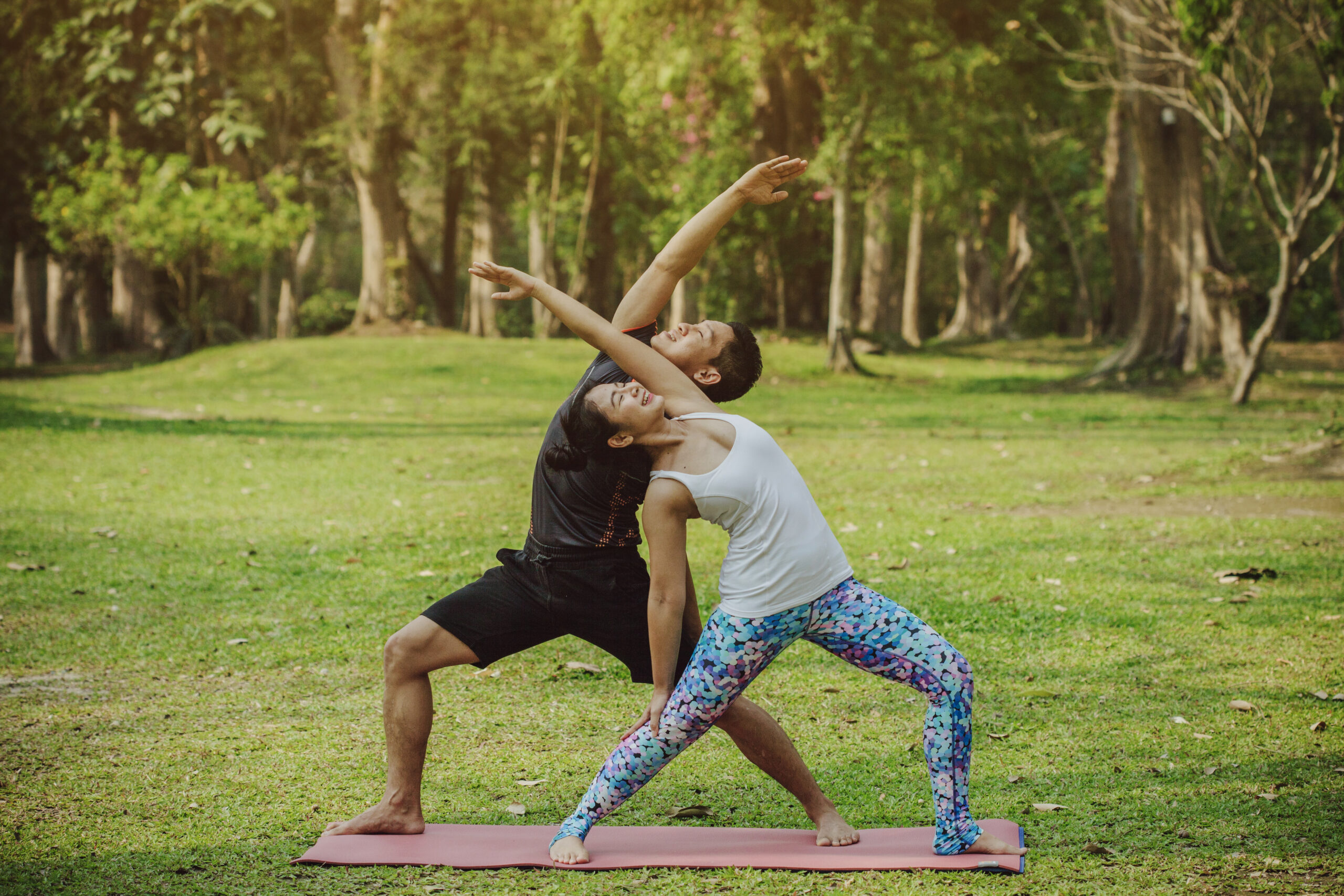
1 thought on “Couple Yoga: 7+ Ultimate Ways to Strengthening Bonds and Bodies”